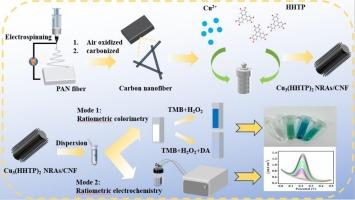Core-shell structured carbon nanofiber-supported bristlegrass-like conductive metal‐organic framework Cu3(HHTP)2 nanorod arrays for electrochemical and colorimetric dual-mode detection of dopamine in serum
IF 4.9
2区 化学
Q1 CHEMISTRY, ANALYTICAL
引用次数: 0
Abstract
Dopamine (DA) is a central neurotransmitter that plays a crucial role in human metabolism. Its precise detection is of great importance in disease diagnosis. Compared with single-signal detection methods, colorimetric and electrochemical dual-signal outputs can self-validate the measured data and counteract interference effects, which is expected to provide more reliable detection results. In this paper, carbon nanofiber-supported 3D bristlegrass-like π-conjugated conducting metal–organic frameworks (cMOF) Cu3(HHTP)2 nanorod arrays (Cu3(HHTP)2 NRAs/CNF) catalyst with core–shell structure are synthesized by electrospinning and solvothermal reaction. The obtained catalyst possesses remarkable peroxidase-like activity which can catalyze the colorless 3,3′,5,5′ −tetramethylbenzidine (TMB) to blue oxTMB. The mechanism study showes that ·OH radicals are the main active substances. Meanwhile, the core–shell structure between π-conjugated cMOF and CNF can effectively inhibit the aggregation of Cu3(HHTP)2 nanorods and generate more catalytic active sites, resulting in strong electrocatalytic activity of Cu3(HHTP)2 NRAs/CNF. As a result, a novel dual-mode sensor based on colorimetric and electrochemical are constructed for detecting dopamine (DA) with a good linear relationship ranging from 2.5-60 μM and 0.1–106 μM, and the limit of detection (LOD) are 0.27 μM and 10.1 nM (S/N=3), respectively. This study opens up a new idea for the application of cMOF peroxidase-like enzyme in sensing field.

芯壳结构碳纳米纤维支撑的刚毛状导电金属有机框架 Cu3(HHTP)2 纳米棒阵列用于电化学和比色法双模式检测血清中的多巴胺
多巴胺(DA)是一种中枢神经递质,在人体新陈代谢中起着至关重要的作用。对其进行精确检测对疾病诊断具有重要意义。与单信号检测方法相比,比色法和电化学双信号输出可自我验证测量数据并抵消干扰效应,有望提供更可靠的检测结果。本文通过电纺丝和溶热反应合成了碳纳米纤维支撑的三维刚毛状π-共轭导电金属有机框架(cMOF)Cu3(HHTP)2 纳米棒阵列(Cu3(HHTP)2 NRAs/CNF)核壳结构催化剂。所获得的催化剂具有显著的过氧化物酶样活性,可将无色的 3,3′,5,5′-四甲基联苯胺(TMB)催化成蓝色的 oxTMB。机理研究表明,-OH 自由基是主要的活性物质。同时,π-共轭 cMOF 与 CNF 之间的核壳结构能有效抑制 Cu3(HHTP)2 纳米棒的聚集,产生更多的催化活性位点,从而使 Cu3(HHTP)2 NRAs/CNF 具有很强的电催化活性。因此,构建了一种新型的基于比色法和电化学法的双模式传感器,用于检测多巴胺(DA),其线性范围分别为 2.5-60 μM 和 0.1-106 μM,检出限(LOD)分别为 0.27 μM 和 10.1 nM(信噪比为 3)。该研究为 cMOF 过氧化物酶样在传感领域的应用开辟了新思路。
本文章由计算机程序翻译,如有差异,请以英文原文为准。
求助全文
约1分钟内获得全文
求助全文
来源期刊

Microchemical Journal
化学-分析化学
CiteScore
8.70
自引率
8.30%
发文量
1131
审稿时长
1.9 months
期刊介绍:
The Microchemical Journal is a peer reviewed journal devoted to all aspects and phases of analytical chemistry and chemical analysis. The Microchemical Journal publishes articles which are at the forefront of modern analytical chemistry and cover innovations in the techniques to the finest possible limits. This includes fundamental aspects, instrumentation, new developments, innovative and novel methods and applications including environmental and clinical field.
Traditional classical analytical methods such as spectrophotometry and titrimetry as well as established instrumentation methods such as flame and graphite furnace atomic absorption spectrometry, gas chromatography, and modified glassy or carbon electrode electrochemical methods will be considered, provided they show significant improvements and novelty compared to the established methods.
文献相关原料
公司名称
产品信息
阿拉丁
L-histidine (L-HIS)
阿拉丁
p-benzoquinone (PBQ)
阿拉丁
acetaminophen (APAP)
阿拉丁
hydroquinone (HQ)
阿拉丁
thiourea
阿拉丁
ascorbic acid (AA)
阿拉丁
ferric trichloride (FeCl3)
阿拉丁
sodium sulfate (Na2SO4)
阿拉丁
Fructose (Fru)
阿拉丁
glucose (Glu)
阿拉丁
sucrose
阿拉丁
lactose (LAc)
阿拉丁
urea
阿拉丁
acetaldehyde
阿拉丁
sodium nitrate (NaNO3)
阿拉丁
potassium chloride (KCl)
阿拉丁
Calcium Chloride (CaCl2)
阿拉丁
sodium chloride (NaCl)
阿拉丁
dopamine (DA)
阿拉丁
anhydrous ethanol (CH3CH2OH)
阿拉丁
copper acetate monohydrate
阿拉丁
2,3,6,7,10,11-hexahydroxytriphenylene
阿拉丁
N, N-dimethylformamide (DMF)
阿拉丁
polyacrylonitrile (PAN)
阿拉丁
Carbon paper
 求助内容:
求助内容: 应助结果提醒方式:
应助结果提醒方式:


